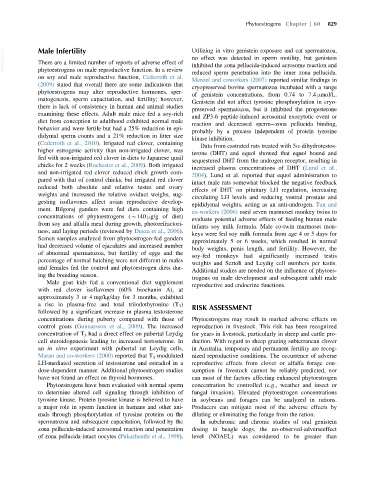Page 871 - Veterinary Toxicology, Basic and Clinical Principles, 3rd Edition
P. 871
Phytoestrogens Chapter | 60 829
VetBooks.ir Male Infertility Utilizing in vitro genistein exposure and cat spermatozoa,
no effect was detected in sperm motility, but genistein
There are a limited number of reports of adverse effect of
inhibited the zona pellucida-induced acrosome reaction and
phytoestrogens on male reproductive function. In a review
reduced sperm penetration into the inner zona pellucida.
on soy and male reproductive function, Cederroth et al.
Menzel and coworkers (2007) reported similar findings in
(2009) stated that overall there are some indications that
cryopreserved bovine spermatozoa incubated with a range
phytoestrogens may alter reproductive hormones, sper-
of genistein concentrations, from 0.74 to 7.4 μmol/L.
matogenesis, sperm capacitation, and fertility; however,
Genistein did not affect tyrosine phosphorylation in cryo-
there is lack of consistency in human and animal studies
preserved spermatozoa, but it inhibited the progesterone
examining these effects. Adult male mice fed a soy-rich
and ZP3-6 peptide-induced acrosomal exocytotic event or
diet from conception to adulthood exhibited normal male
reaction and decreased sperm zona pellucida binding,
behavior and were fertile but had a 25% reduction in epi-
probably by a process independent of protein tyrosine
didymal sperm counts and a 21% reduction in litter size
kinase inhibition.
(Cederroth et al., 2010). Irrigated red clover, containing
Data from castrated rats treated with 5α-dihydrotestos-
higher estrogenic activity than non-irrigated clover, was
terone (DHT) and equol showed that equol bound and
fed with non-irrigated red clover in diets to Japanese quail
sequestered DHT from the androgen receptor, resulting in
chicks for 2 weeks (Rochester et al., 2009). Both irrigated
increased plasma concentrations of DHT (Lund et al.,
and non-irrigated red clover reduced chick growth com-
2004). Lund et al. reported that equol administration to
pared with that of control chicks, but irrigated red clover
intact male rats somewhat blocked the negative feedback
reduced both absolute and relative testes and ovary
effects of DHT on pituitary LH regulation, increasing
weights and increased the relative oviduct weighs, sug-
circulating LH levels and reducing ventral prostate and
gesting isoflavones affect avian reproductive develop-
epididymal weights, acting as an anti-androgen. Tan and
ment. Bilgoraj ganders were fed diets containing high
co-workers (2006) used seven marmoset monkey twins to
concentrations of phytoestrogens (B140 μg/g of diet)
evaluate potential adverse effects of feeding human male
from soy and alfalfa meal during growth, photorefractori-
infants soy milk formula. Male co-twin marmoset mon-
ness, and laying periods (reviewed by Dusza et al., 2006).
keys were fed soy milk formula from age 4 or 5 days for
Semen samples analyzed from phytoestrogen-fed ganders
approximately 5 or 6 weeks, which resulted in normal
had decreased volume of ejaculates and increased number
body weights, penis length, and fertility. However, the
of abnormal spermatozoa, but fertility of eggs and the
soy-fed monkeys had significantly increased testis
percentage of normal hatching were not different in males
weights and Sertoli and Leydig cell numbers per testis.
and females fed the control and phytoestrogen diets dur-
Additional studies are needed on the influence of phytoes-
ing the breeding season.
trogens on male development and subsequent adult male
Male goat kids fed a conventional diet supplement
reproductive and endocrine functions.
with red clover isoflavones (60% biochanin A), at
approximately 3 or 4 mg/kg/day for 3 months, exhibited
a rise in plasma-free and total triiodothyronine (T 3 ) RISK ASSESSMENT
followed by a significant increase in plasma testosterone
concentrations during puberty compared with those of Phytoestrogens may result in marked adverse effects on
control goats (Gunnarsson et al., 2009). The increased reproduction in livestock. This risk has been recognized
concentration of T 3 had a direct effect on pubertal Leydig for years in livestock, particularly in sheep and cattle pro-
cell steroidogenesis leading to increased testosterone. In duction. With regard to sheep grazing subterranean clover
an in vitro experiment with pubertal rat Leydig cells, in Australia, temporary and permanent fertility are recog-
Maran and co-workers (2000) reported that T 3 modulated nized reproductive conditions. The occurrence of adverse
LH-mediated secretion of testosterone and estradiol in a reproductive effects from clover or alfalfa forage con-
dose-dependent manner. Additional phytoestrogen studies sumption in livestock cannot be reliably predicted, nor
have not found an effect on thyroid hormones. can most of the factors affecting enhanced phytoestrogen
Phytoestrogens have been evaluated with normal sperm concentration be controlled (e.g., weather and insect or
to determine altered cell signaling through inhibition of fungal invasion). Elevated phytoestrogen concentrations
tyrosine kinase. Protein tyrosine kinase is believed to have in soybeans and forages can be analyzed in rations.
a major role in sperm function in humans and other ani- Producers can mitigate most of the adverse effects by
mals through phosphorylation of tyrosine proteins on the diluting or eliminating the forage from the ration.
spermatozoa and subsequent capacitation, followed by the In subchronic and chronic studies of oral genistein
zona pellucida-induced acrosomal reaction and penetration dosing in beagle dogs, the no-observed-adverseeffect
of zona pellucida-intact oocytes (Pukazhenthi et al., 1998). level (NOAEL) was considered to be greater than

